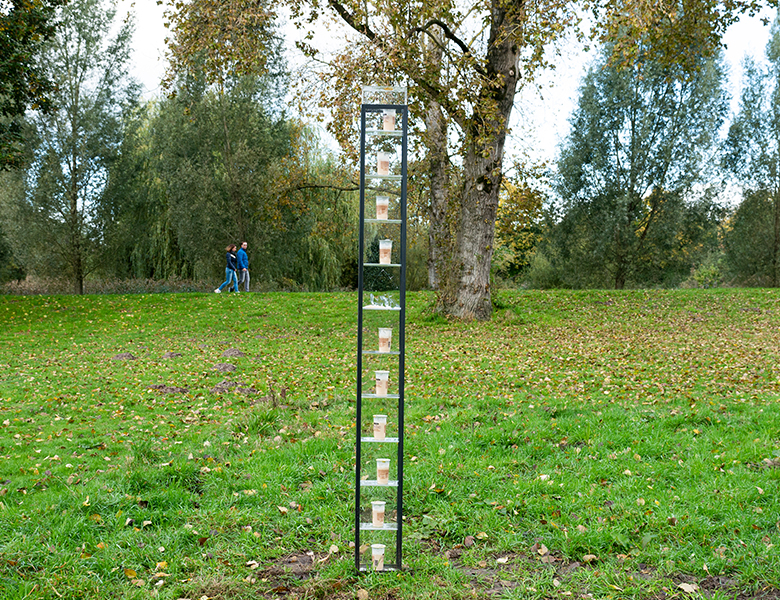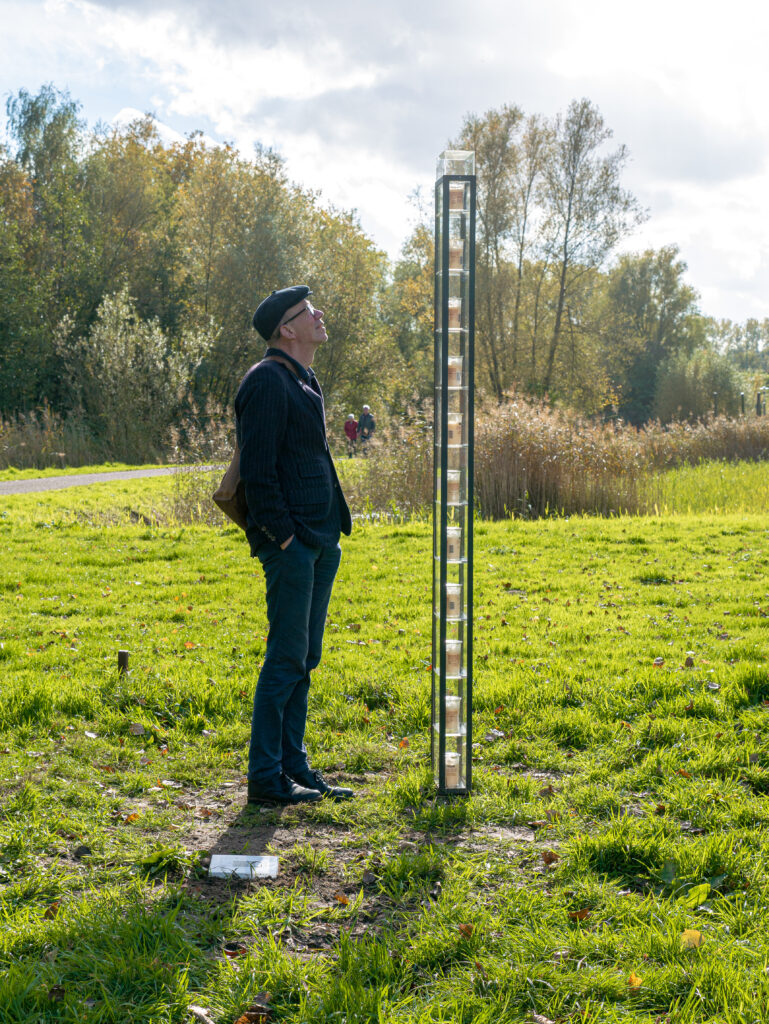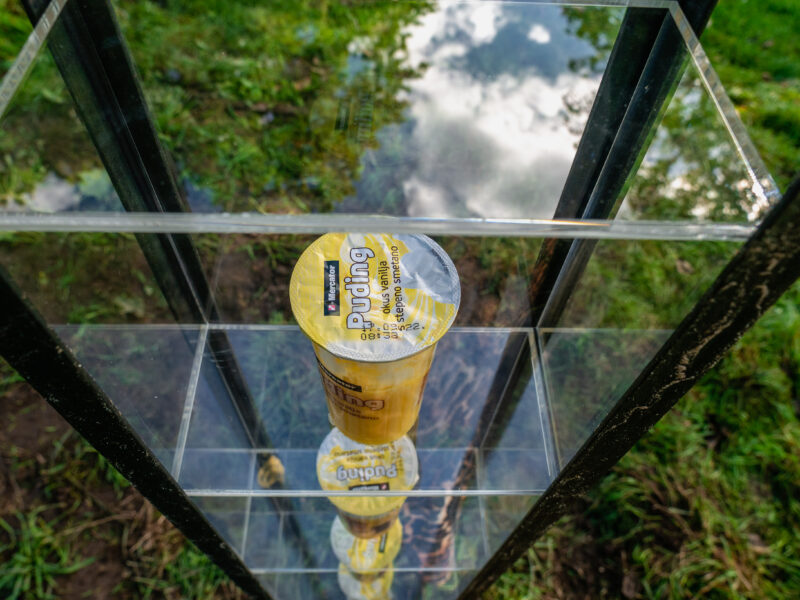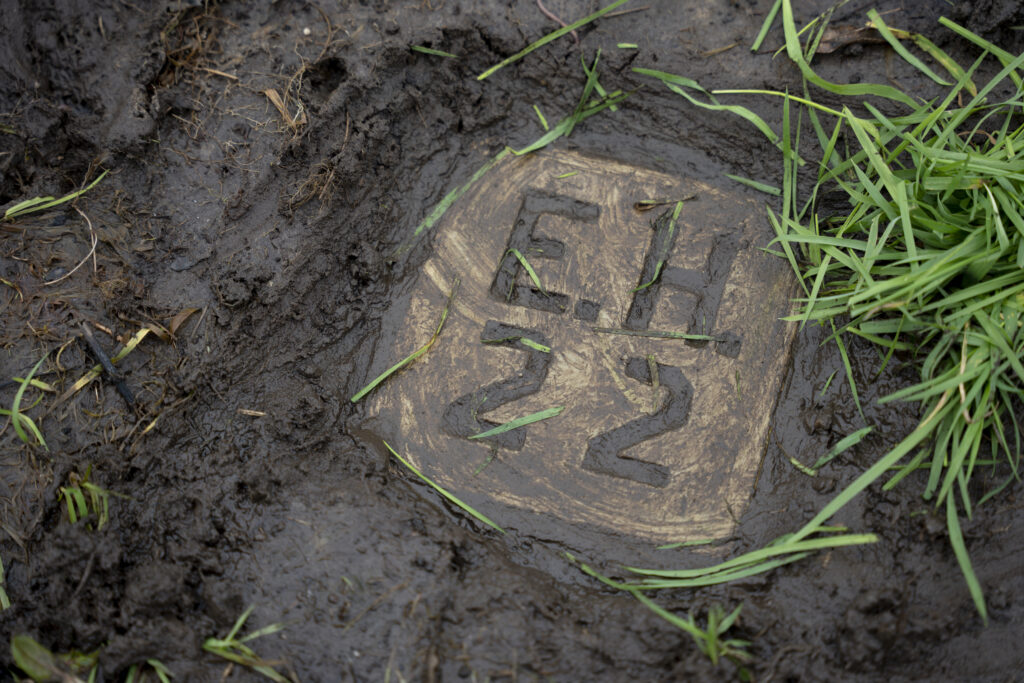 Agenda
Artikelen
Programma
Agenda
Artikelen
Programma

Article by Ruth de Vos, reflecting upon the work ‘Event Horizon’ by Urša Prek.
URŠA PREK – A MONUMENT FOR FUTURE GENERATIONS
When I saw the work Event Horizon by Urša Prek (1993, Slovenia) for the first time, it reminded me of an event that happened a few years ago. The discovery of a mysterious monolith in the remote Utah desert in the United States that made headlines across the world. For days there was speculation about the origin of the three meters high shiny metal plank. Art connoisseurs saw the hand of a minimal artist in it, others cited the film A Space Odyssey as a source of inspiration for the mysterious object. Still others did research via online satellite images and argued that the monolith had been there for at least several years. Just as quickly as it appeared, the monolith vanished. Visitors to the desert saw strangers pull it over, load it into the back of a truck and drive it away. It will probably always remain a mystery by whom and why the statue was placed.
In September 2022, a monolith appeared in the Zaartpark in Breda, consisting of a steel frame with eleven stacked plexiglass boxes. Each box contained a single plastic cup of vanilla pudding. I like to imagine that for the visitors of the park this work was just as mysterious as the work in Utah; where did it come from, who made it and why on earth would anyone put in so much work for a few desserts?
A very trivial and cheap product was put on a pedestal by the work presented in the Zaartpark. In the 20th century, Pop Art artists sought to mix ‘high’ and ‘low’ art by using these types of everyday objects as subjects for art. But that’s not only what the artist of this work, Urša Prek was looking for. Although she certainly values the humorous effect of elevating an everyday object, what matters to her is the memory attached to the object.

When Prek was contemplating the name of the work, she doubted between monument and monolith. The word monument comes from the Latin monumentum meaning ‘memorial’ or ‘that which remembers’. Erecting a monument is a way of preserving a memory and ensuring that the memory of the event is not lost. The memory is transferred to the object and therefore does not have to remain permanently in people’s heads. A monument is usually erected to keep the memory of important events or people alive, but Prek uses it to record a very small and also hyper-personal memory. In the end, Prek decided that monolith was a more appropriate name for the work. A monolith, or a large piece of stone that has been put upright, is actually also a monument. The thing is it has been there for so long that no one remembers its original purpose. This is also the connection with the meaning of her work: Event Horizon is an attempt to connect to a memory she can’t remember the context of.
The memory associated with the dessert is very vivid and sharp for Prek and she knows exactly where it took place. She ate the dessert when she was five years old in her late father’s apartment. She just has no idea what else happened besides eating dessert. Why has this memory remained so clear and bright, what is so important about the dessert, what has she forgotten and can the dessert be a way to activate her memory? The title of the work also refers to this. Event horizon is a concept from cosmology that describes the boundary beyond which information, matter or light, can no longer reach a certain other point. Just like how Prek’s memory of eating dessert has become a point in time she can no longer access.
Most people have few memories of their early childhood. For most adults the earliest memories begin at the age of three and a half. Science has not yet figured out how it is possible that people only start to make memories at a later age that can actually be recollected. Possible explanations for not remembering one’s early years are that the brain is not fully developed yet at this age, or that young children don’t have the right words or language yet to properly ‘store’ their memories.
The philosopher Plato described one’s memory as a library in which each new entry is a different book. The more books there are in your library, the more difficult it is to find the right one. Many scientists now agree that the memory is not fixed but changes continuously under the influence of following experiences. It works through concepts that are linked together. This way, memories can be triggered by objects because they activate the link. Remembering is therefore a very associative process and context is important because every experience takes place in a different environment.

Prek was born in Slovenia and studied at the art academy in Ljubljana. Her work from this period was already about time and space, but it was only during an exchange program at the St Joost art academy in Breda that subjects such as time and space of memories entered her work. In order to approach the level of intimacy of the personal recollection as closely as possible, the desserts in the monolith all come from Slovenia. The work is about the distance she feels from her own youth, and the literal distance she has from Slovenia while living and working in the Netherlands.
It is not the first time that Prek has incorporated desserts in her work. In 2018 she made the work Daddyland, an installation in Alkatraz gallery in Ljubljana in Slovenia, wherein she used objects from her fathers apartment who just passed away. Being present in her father’s apartment gave her the feeling of being close but at the same time far away. The installation was an attempt to understand what those objects meant to her. The vanilla pudding also had a place in the installation and, strangely enough, was the thing that stayed with her the most after breaking down the work. It turned out to be the part that had the most powerful memory and with that came the idea to dedicate a new work especially to the dessert.
With her work, Prek poses the question of the function of objects in the process of remembering. Is it possible to retrieve lost memories and what role does distance play in this? What is the function of memories in the process of shaping one’s identity? Do memories make you who you are and if you remember more, do you also get understand more about yourself? Who was I before and how do all those previous versions of me coincide in the present day? What does that mean for me in the future?
Event Horizon is about an intimate, personal memory, but the installation in the park made Prek notice that the pudding cups also evoke memories in other people. During the construction and follow-up visits to the park, she spoke to several passers-by who reminisced about similar puddings that are also sold in the Netherlands. Someone told her about a memory of a traumatic stay in the hospital where she was fed this kind of dessert.

Prek was invited by Witte Rook to fill in the autumn quarter within Gerrit-Jan Smit’s 49m2 project, which is located in the Zaartpark in Breda (see side-box for more information about this project). The monolith therefore remained in the park for three months. During that time she has been back regularly to view and record the state of the work. During their stay in the boxes in the Zaartpark, the puddings changed color and shape. The desserts discolored under the influence of the sun and became increasingly lighter in color. Their plastic containers deformed under the influence of gas formation and decomposition.
Although fairly vandal-proof, the work has been considerably damaged a number of times. The first time was before the opening moment. Someone opened one of the compartments, as if it were a vending machine, and pulled out a pudding cup. That will probably not have tasted well because the desserts were by now expired. Fortunately, the artist had foreseen this and had arranged for extra desserts that allowed her to restore the work. Besides this event, the work was destroyed twice more by breaking the glass and pulling boxes from the frame. According to Prek, the vandals had to have been well prepared because they must have needed large tools to cause the amount of damage done. Fortunately, it was possible to restore the monolith every time, and the damages has become now part of the story of the work.
At the end of autumn, Prek returned to Zaartpark to complete the final part of the work. She buried a box with a pudding cup in it in the 49m2 sand in the Zaartpark under a concrete stone that she made herself. For Prek, the pudding is a symbol of her past and the box is a time capsule in which the memory has become tangible. To be dug up in the future by new generations.
Photography & video: Jamie Jansen
In addition to this text, Urša also created her own observation which contains the videowork ‘Shedding’ as well as the three month observation in photo’s. You can check these out here: 49m2 (observation)